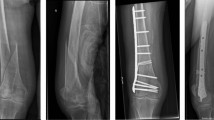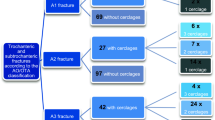Abstract
Purpose
Reduction and intramedullary fixation of subtrochanteric fractures is often challenging. Osteosynthesis frequently fails and a higher rate of non-unions is found. The aim of this study was to evaluate the benefit of an additional cerclage to anatomically reduce and support the medial hinge. The application is based on the experience of the surgeon; as yet no biomechanical data are available.
Methods
Ten pairs of human cadaveric femora were used to determine the biomechanical and clinical advantage of an additional cerclage. All femora were tested in a materials testing system after osteotomy, osteosynthesis with the Gamma III nail and randomisation into two groups with or without additional cerclage.
Results
After cyclic loading the compressive load to reach plastic deformation of 5 mm was 2,160 N on average in the group without cerclage vs 2,330 N on average in the group with cerclage. This biomechanical advantage showed no statistical significance (p = 0.2). Radiological examination when the abort criterion was reached revealed that use of the additional wire cerclage could significantly decrease the failure of osteosynthesis (100 vs 10%) after intramedullary nailing of subtrochanteric fractures (p < 0.05).
Conclusion
In view of the more invasive operative approach with additional soft tissue injuries, application of an additional cerclage should still be considered carefully. Nevertheless, a mini-open approach to difficult fractures could be helpful in reducing the fracture with a clamp and is sometimes essential. The damage to the soft tissue must be weighed against the benefits of the procedure. An additional cerclage in oblique subtrochanteric fractures is a good option to ensure the reposition and cortical medial support if appropriate and to decrease osteosynthesis failure and rates of non-unions.





Similar content being viewed by others
References
Federal Statistical Office (2010) 11th coordinated projection of population, modification 1-W1
BQS, Institute for Quality and Patient Safety
Wheeler DL, Croy TJ, Woll TS, Scott MD, Senft DC, Duwelius PJ (1997) Comparison of reconstruction nails for high subtrochanteric femur fracture fixation. Clin Orthop Relat Res 338:231–239
Craig NJ, Sivaji C, Maffulli N (2001) Subtrochanteric fractures. A review of treatment options. Bull Hosp Jt Dis 60(1):35–46
Sims SH (2002) Subtrochanteric femur fractures. Orthop Clin North Am 33(1):113–126, viii
Loizou CL, McNamara I, Ahmed K, Pryor GA, Parker MJ (2010) Classification of subtrochanteric femoral fractures. Injury 41(7):739–745
Koch JC (1917) The laws of bone architecture. Am J Anat 21:177–298
Rosenblum SF, Zuckerman JD, Kummer FJ, Tam BS (1992) A biomechanical evaluation of the Gamma nail. J Bone Joint Surg Br 74(3):352–357
Mahomed N, Harrington I, Kellam J, Maistrelli G, Hearn T, Vroemen J (1994) Biomechanical analysis of the Gamma nail and sliding hip screw. Clin Orthop Relat Res 304:280–288
Hajdu S, Vécsei V (2007) Intramedullary stabilization of proximal femoral fractures. Eur J Trauma Emerg Surg 33:141–148
Taeger G, Schmid C, Zettl R, Schweiberer L, Nast-Kolb D (2000) Stable and unstable pertrochanteric femoral fractures. Differentiated indications for the dynamic hip screw (in German). Unfallchirurg 103(9):741–748
Bridle SH, Patel AD, Bircher M, Calvert PT (1991) Fixation of intertrochanteric fractures of the femur. A randomised prospective comparison of the gamma nail and the dynamic hip screw. J Bone Joint Surg Br 73(2):330–334
Heinz T, Vécsei V (1994) Complications and errors in use of the gamma nail. Causes and prevention (in German). Chirurg 65(11):943–952
Leung KS, So WS, Shen WY, Hui PW (1992) Gamma nails and dynamic hip screws for peritrochanteric fractures. A randomised prospective study in elderly patients. J Bone Joint Surg Br 74(3):345–351
Roberts CS, Nawab A, Wang M, Voor MJ, Seligson D (2002) Second generation intramedullary nailing of subtrochanteric femur fractures: a biomechanical study of fracture site motion. J Orthop Trauma 16(4):231–238
Curtis MJ, Jinnah RH, Wilson V, Cunningham BW (1994) Proximal femoral fractures: a biomechanical study to compare intramedullary and extramedullary fixation. Injury 25(2):99–104
Kummer FJ, Olsson O, Pearlman CA, Ceder L, Larsson S, Koval KJ (1998) Intramedullary versus extramedullary fixation of subtrochanteric fractures. A biomechanical study. Acta Orthop Scand 69(6):580–584
Kraemer WJ, Hearn TC, Powell JN, Mahomed N (1996) Fixation of segmental subtrochanteric fractures. A biomechanical study. Clin Orthop Relat Res 332:71–79
Lahoud JC, Asselineau A, Salengro S, Molina V, Bombart M (1997) Sub-trochanteric fractures. A comparative study between gamma nail and angular osteosynthesis with lateral cortical support (in French). Rev Chir Orthop Reparatrice Appar Mot 83(4):335–342
van Doorn R, Stapert JW (2000) The long gamma nail in the treatment of 329 subtrochanteric fractures with major extension into the femoral shaft. Eur J Surg 166(3):240–246
Barquet A, Francescoli L, Rienzi D, López L (2000) Intertrochanteric-subtrochanteric fractures: treatment with the long Gamma nail. J Orthop Trauma 14(5):324–328
Hohendorff B, Meyer P, Menezes D, Meier L, Elke R (2005) Treatment results and complications after PFN osteosynthesis (German). Unfallchirurg 108(11):938–940, 941–6 passim
Fogagnolo F, Kfuri M Jr, Paccola CA (2004) Intramedullary fixation of pertrochanteric hip fractures with the short AO-ASIF proximal femoral nail. Arch Orthop Trauma Surg 124(1):31–37
Pauwels F (1965) Collection of papers of the functional anatomy of the musculoskeletal system. Springer, Berlin
Bonnaire F, Weber A, Bösl O, Eckhardt C, Schwieger K, Linke B (2007) “Cutting out” in pertrochanteric fractures–problem of osteoporosis (in German)? Unfallchirurg 110(5):425–432
Skála-Rosenbaum J, Bartonícek J, Bartoska R (2010) Is distal locking with IMHN necessary in every pertrochanteric fracture? Int Orthop 34(7):1041–1047
Acknowledgements
Thanks to Daniel Harich, graduate engineer, design engineer, for the support in our study design.
Conflict of interest
The authors declare that they have no conflict of interest.
Author information
Authors and Affiliations
Corresponding author
Rights and permissions
About this article
Cite this article
Müller, T., Topp, T., Kühne, C.A. et al. The benefit of wire cerclage stabilisation of the medial hinge in intramedullary nailing for the treatment of subtrochanteric femoral fractures: a biomechanical study. International Orthopaedics (SICOT) 35, 1237–1243 (2011). https://doi.org/10.1007/s00264-010-1204-4
Received:
Accepted:
Published:
Issue Date:
DOI: https://doi.org/10.1007/s00264-010-1204-4




